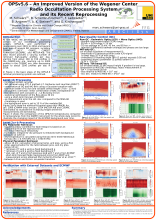OPSv5.6 – An Improved Version of the Wegener Center Radio Occultation Processing System and its recent Re-processing
Marc
Schwärz
Wegener Center for Global and Climate Change (WEGC) and Institute of Physics, University of Graz, Graz, Austria
Poster
At the Wegener Center (WEGC) we developed an improved version of our occultation processing system, OPSv5.6, and performed a reprocessing of available radio occultation (RO) measurements over 2001 to 2016 with a careful quality control. The WEGC OPSv5.6 RO record consists of data from several RO missions, including CHAMP, SAC-C, GRACE, C/NOFS, FORMOSAT-3/COSMIC, and METOP-A/B. The data record provides a varying amount of retrieved high-quality profiles per day (number of fully processed RO events per day), starting from about 100 to 150 profiles in the CHAMP-only era, reaching up to 3000 profiles in the COSMIC era, then decreasing to a number of about 1500 profiles in 2016.
The OPSv5.6 record is serving as input for a large number of studies regarding the investigation of atmospheric and climate processes, the analysis of atmospheric variability and the detection of climate trends as well as long-term validation of other atmospheric satellite data products such as from the Envisat satellite of ESA.
In this presentation we discuss relevant details of the OPSv5.6 retrieval. We start with the preprocessing of the excess phase data and the bending angle retrieval, and describe the settings of the high altitude initialization of bending angles which then serves as input to the refractivity retrieval. The specific setup of the dry atmospheric profiles retrieval is illustrated and finally, the new moist air retrieval, which is the last step of the atmospheric profiles
retrieval, is addressed.
We will furthermore present the datasets recently provided by the OPSv5.6 re-processing over 2001 to 2016: The retrieved profiles (comprising the variables bending angle, refractivity, dry pressure and dry temperature as well as physical temperature, pressure, and humidity), the derived variables and parameters such as geopotential height of pressure levels,
boundary layer, tropopause, and stratopause heights, and finally the gridded climatology fields of all variables.
The OPSv5.6 record is serving as input for a large number of studies regarding the investigation of atmospheric and climate processes, the analysis of atmospheric variability and the detection of climate trends as well as long-term validation of other atmospheric satellite data products such as from the Envisat satellite of ESA.
In this presentation we discuss relevant details of the OPSv5.6 retrieval. We start with the preprocessing of the excess phase data and the bending angle retrieval, and describe the settings of the high altitude initialization of bending angles which then serves as input to the refractivity retrieval. The specific setup of the dry atmospheric profiles retrieval is illustrated and finally, the new moist air retrieval, which is the last step of the atmospheric profiles
retrieval, is addressed.
We will furthermore present the datasets recently provided by the OPSv5.6 re-processing over 2001 to 2016: The retrieved profiles (comprising the variables bending angle, refractivity, dry pressure and dry temperature as well as physical temperature, pressure, and humidity), the derived variables and parameters such as geopotential height of pressure levels,
boundary layer, tropopause, and stratopause heights, and finally the gridded climatology fields of all variables.

Poster PDF
Abstract file